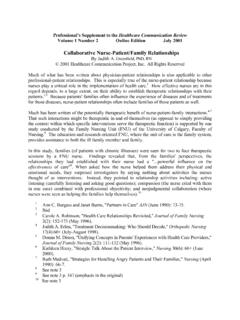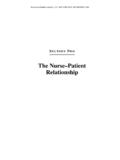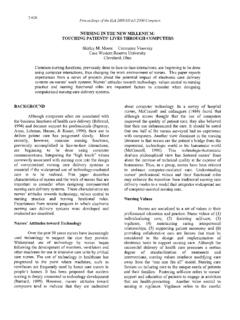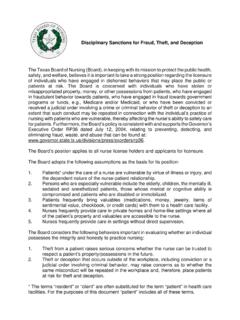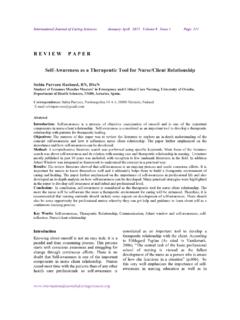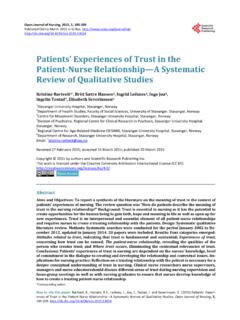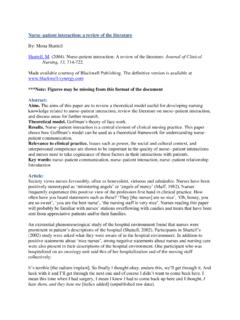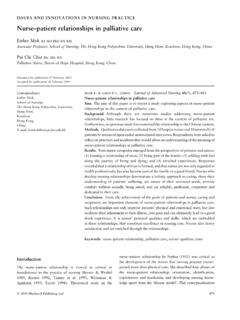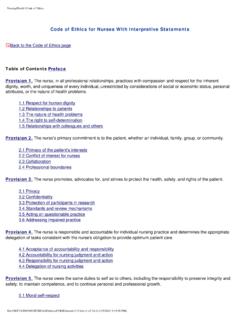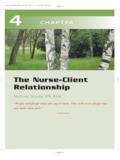Transcription of Nursing Model: Jean Watson’s Caring Theory
1 Nursing Model 1 Nursing Model: jean watson s Caring Theory Gina Gessner Georgetown University Nursing Model 2 watson s model of Caring was developed originally in the 1970 s and amended many times to the postmodern transpersonal Caring -healing paradigm (1999) which is applicable to the practice of Nursing and other disciplines (Fitzpatrick & Whall, 2005) . watson believes that many concepts identified by Florence Nightingale and other leaders in Nursing are still valid to modern clinicians and has adopted these traditional concepts into her Caring model. Such themes include, the view of the human as a valued person in and of him-or herself to be cared for, respected, nurtured, understood and assisted as well as, an emphasis on human-to-human care transaction between the nurse and person.
2 Fitzpatrick and Whall also explain that watson believes both client and practitioner are to actively participate in healing and Caring by, experiencing the quantum energy fields conducive to healing from a spiritual, mystical environment (2005, p. 297). Many of her concepts have a spiritual element that affects both the nurse and the client, allowing them to connect deeply and transcend the moment (Fitzpatrick & Whall, 2005). watson s model can best be described in terms of the Nursing metaparadigm. When describing Nursing , watson proclaims that Caring is the moral ideal (1988, ). She explains that contact between two human beings can help the ill discover new knowledge that will assist with recovery and promote harmony.
3 The nurse is involved in a partnership with the patient in the Caring process in which the goal is intersubjectivity. watson explains that because Nursing is a human science, there are important moral, spiritual and metaphysical components and we can use our spirits to relate to others ( watson , 1988). In describing the person, watson believes that the person has three elements within them which are the mind, body and soul, all of which are influenced by the self. A person is both a physical being and a spiritual being, with an individual experience and existence. She describes a person as, the experiencing or perceiving organism. Nursing Model 3 The person and the self are the same when the person is congruent with the real self.
4 That occurs when there is harmony in the mind, body and soul of the person ( watson , 1988, ). The previous sentiment about harmony between all three aspects of person can be used to describe health. Health also encompasses unity of the self with others and the environment (Fitzpatrick & Whall, 2005). Health and the client s perceived sense of health must be in balance as well for true health to exist ( watson , 1988). Her original definition of health was based on the World Health Organization s model which and then transformed into a more unconventional and spirituality influenced as the model developed (Fitzpatrick & Whall, 2005). watson discusses environment in more abstract terms. Environments should be transformative in nature.
5 She believes that Caring and healing must be able take place in an environment that the nurse helps create. The nurse helps regulate the environment, making sure all factors for healing are present, such as support, protection and spirituality (Fitzpatrick & Whall, 2005). watson describes ten central components called carative factors that serve as the basis of her Theory . These carative factors transcend many of the traditional ideas of Nursing yet evoke the dogma of Nightingale (Fitzpatrick & Whall, 2005). Major points of the carative factors include altruism, love, trust, creativity, teaching, and spirituality ( watson , 1988). The factors can be used as an entry way into the Theory and be built upon to comprehend more philosophical and complex themes.
6 It is evident that these carative factors influence her beliefs on all aspects of the Nursing metaparadigm. watson s model of Caring supports the huge paradigm shift in the field of Nursing . The curriculum revolution, as it has been called, has focused on departing from the conventional behaviorist and medical model to one rooted in humanistic values with Caring as its central focus. Bevis states, Nursing has a social mandate toward shaping a healthcare system that is more Nursing Model 4 efficacious, just, equitable and Caring (1993, p. 56). Many scholars support this shift and watson s model that embodies Caring , transpersonal relationships and spirituality fits well within this newer set of beliefs.
7 Interestingly, Caring is far from a new concept. While it may be traditional it is also unique to the field of Nursing , and many educators and experts believe it is an essential component to the curriculum. Integrating Caring into curriculum is especially important in today s healthcare environment, where high patient acuity and technological advances threaten the sacredness of the nurse patient relationship ( watson , 2009). When a college or university adopts watson s Theory as a framework, a Nursing student obtains an education that has Caring central to all aspects of the curriculum. Therefore, her model and concepts within the model are used in many Nursing curriculums today. If one is to explore educational philosophies of Nursing schools, almost all make some reference to Caring .
8 Not surprisingly, the Caring model has been used at the University of Colorado where watson serves as professor. The College s values include the belief that, Nursing is a Theory -guided, evidence-based practice, focused on holistic, relationship -centered Caring that facilitates health and healing ( ). Certain Universities have used Dr. watson s Caring model as an influence and formed their own theories based on her core beliefs, such as watson did with Rogers. At the Catholic University of America, Dr. Duffy created the Quality Caring Model. It is described as a, mid-range Theory reflect[ing] Nursing 's unique role within a multidisciplinary health care system and places Caring relationships at the center of nurses' work ( ).
9 Similar to watson s beliefs, this Theory places Nursing Model 5 importance on relationships and the interaction between the patient and nurse where Caring can occur and is paramount. A multitude of studies have been performed nationally and worldwide focused on the integration of Caring into the Nursing curriculum. For example, a study by Sawatzky, et. al., aimed to show that a Caring model can also be applied to Nursing education as well as patient care. She argues that one s teaching philosophy should be intertwined with one s own Nursing philosophy, and Caring is at the root of Nursing (Sawatzky, et. al, 2009). In watson s Caring model, she emphasizes the importance of the nurse client relationship .
10 She identifies the agent of change in the healing process as an intersubjective interdependent process wherein both persons may transcend self and usual experiences ( watson , 1988, ). Nursing researchers claim that this personal relationship applied to the client and nurse also applied to student teacher interactions (Sawatzky, et. al., 2009). The study also suggests that the nurse educator with a strong Caring ethic should serve as a role model for the student. As a result, their beliefs will pervade all aspects of the curriculum and the student will learn similar values (Sawatzky, et. al., 2009). Cook and Cullen studied the restructuring of an associate degree Nursing program using watson s Caring model (2003).



